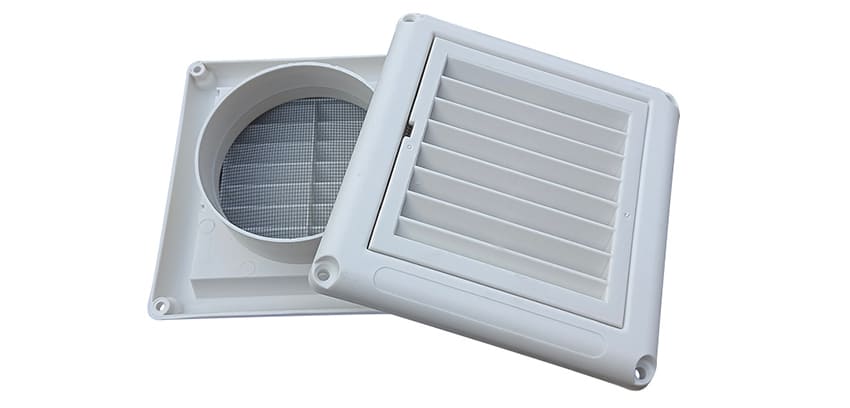AIREVERPEAK(XingSheng), where our years of dedication and expertise in manufacturing HVAC Plastic Air Diffusers, Louvers, and Grilles have established us as a leader in the industry. Our commitment to quality, innovation, and customer satisfaction is reflected in our numerous certifications and awards.
Our Certifications and Accolades:
- National Industrial Products Production License
- European Union CE Certification
- United States Market UL Certification
- ISO 9001 Quality Management System Certification
- ISO 14001 Environmental Management System Certification
- OHSAS 18000 Occupational Health and Safety Certification
- Energy Saving and Low Carbon Certification
- Mechanical and Electrical Equipment Installation Qualification II issued by the Ministry of Construction
- AAA Level Enterprise Recognition
- Jiangsu Famous Brand
- Top 100 Excellent Enterprises in China’s Refrigeration Industry
- Top Ten National Brands in China’s Refrigeration Industry
- Our Air Conditioner Terminal Products Rated as Top Ten Brands in China
Basic Introduction of Plastic Air Diffusers Louvers & Grilles
- Quality Assurance: With our comprehensive certifications, we guarantee products of the highest quality and safety standards.
- Customized Solutions: We offer tailor-made products to fit your specific needs, ensuring efficiency and functionality.
- Energy Efficiency: Our energy-efficient designs contribute to reducing operational costs and supporting environmental sustainability.
- Renowned Reputation: As a recognized leader in the industry, we’re committed to maintaining the high standards that earned us national and international accolades.
- Cost-Effective Solutions: We provide competitive pricing, ensuring you receive the best value for your investment.
Feature Description
- Made of ABS/PP plastic
- White color as standard, customized is acceptable
- Easy installation by clips on the back of the grille
- The butterfly damper was controlled by the centre plug on the face
- Optional: Plastic or metal mesh
- Optional: Polybag with cutting template
- Optional: Polybag & individual inner box ( with cutting template)
Basic styles and sizes of Plastic Air Diffusers Louvers & Grilles
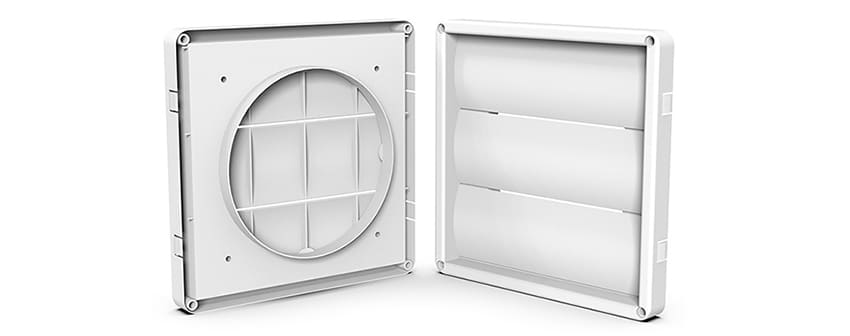
If you want to know more, please click below:
- HVAC Linear Slot Diffusers – The Ultimate Guide
- HVAC Egg Crate Diffuser – The Ultimate Guide
- HVAC Jet Nozzle Diffuser – The Ultimate Guide
- HVAC Linear Bar Grilles – The Ultimate Guide
- HVAC Air Swirl Diffusers – The Ultimate Guide
- HVAC Round Ceiling Diffusers – The Ultimate Guide
- Round Ceiling Diffusers – The Ultimate Guide
- HVAC Return Air Grille – The Ultimate Guide
- Exhaust Air Louver – The Ultimate Guide
- HVAC Registers – The Ultimate Guide
HVAC Plastic Air Diffusers Louvers & Grilles – The Ultimate Guide
1. What are the main types of plastic air diffusers available for HVAC systems?
Plastic air diffusers in HVAC systems come in various types, each serving distinct airflow and aesthetic purposes. From ceiling diffusers ideal for uniform air distribution in offices to jet diffusers suitable for large, open spaces, the choice depends on the specific requirements and design considerations of your HVAC system.
- Design: Typically square or circular in shape, these diffusers are installed in ceiling tiles or directly into the ceiling.
- Function: They distribute air evenly across the room, often featuring louvers or adjustable plates for directional control of airflow.
- Applications: Commonly used in office spaces, retail areas, and residential settings.
- Appearance: Known for their sleek, linear design, these diffusers offer a modern look.
- Airflow Control: They provide a continuous air distribution pattern, which can be adjusted for directional flow.
- Placement: Ideal for installation along walls or ceilings, particularly in contemporary commercial spaces.
- Unique Feature: Swirl diffusers use a series of blades to create a swirling airflow pattern.
- Efficiency: This design enhances air mixing and rapid temperature equalization in the room.
- Suitability: Often used in large public spaces like airports or conference centers.
- Design and Use: These are placed on the floor, particularly in environments where ceiling distribution is not feasible.
- Durability: Made from robust plastics, they are designed to withstand foot traffic and other stresses.
- Application: Common in industrial settings and data centers.
- High Airflow Design: Jet diffusers are capable of delivering air over long distances, with a focused, high-velocity airflow.
- Adjustability: They often feature adjustable nozzles to direct airflow precisely.
- Use Case: Ideal for large spaces like auditoriums, warehouses, or where targeted air distribution is required.
Considerations for Choosing Plastic Diffusers
- Aesthetic Compatibility: Consider how the diffuser will blend with the architectural design.
- Airflow Requirements: Choose a diffuser type based on the specific airflow patterns and volume requirements of the space.
- Durability and Maintenance: Evaluate the durability of the plastic and the ease of maintenance.
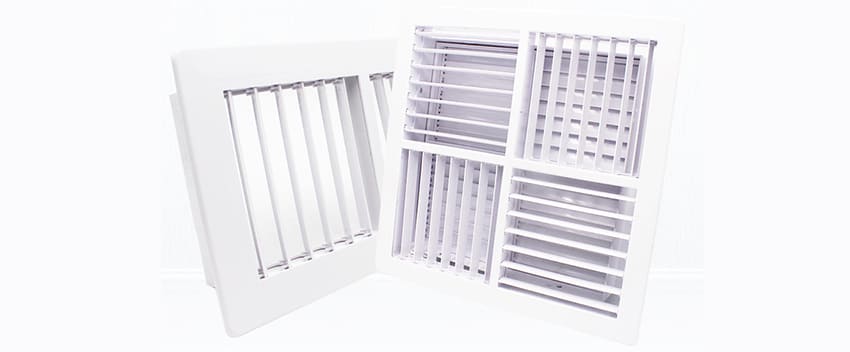
2. How do plastic louvers and grilles differ in function and design?
In HVAC systems, both plastic louvers and grilles are integral components, yet they serve different purposes and have distinct designs. While louvers provide control and protection for air intake and exhaust, grilles offer an aesthetically pleasing solution for air distribution within rooms.
Plastic Louvers: Function and Design
- Purpose: Louvers are designed primarily for controlling the airflow direction and aiding in ventilation. They can be adjusted to direct air in specific directions.
- Adjustable Slats: Typically, louvers consist of parallel slats that can be angled to regulate airflow and light penetration.
- Ventilation Efficiency: They are particularly effective in promoting natural ventilation and protecting against water and debris ingress.
- Design Aesthetics: Louvers often have a more industrial appearance and are commonly used in exterior applications or in areas where direct airflow control is necessary.
Plastic Grilles: Function and Design
- Purpose: Grilles, in contrast, are mainly used as covers for air duct openings. Their primary function is to distribute air evenly throughout the space and prevent large objects from entering the ducts.
- Fixed or Decorative Patterns: Unlike louvers, grilles usually have fixed, non-adjustable patterns. They come in various decorative designs, making them more aesthetically versatile.
- Air Dispersal: Grilles are designed to disperse air across a wider area without the option to direct or control the airflow precisely.
- Application Areas: They are often found in residential and commercial interiors, contributing to the décor while serving a functional purpose.
Comparing Louvers and Grilles
- Airflow Control: Louvers offer more control over airflow direction, while grilles provide a more uniform air distribution without directional control.
- Design Flexibility: Grilles offer more decorative options, blending with interior aesthetics, whereas louvers have a more functional design.
- Installation Locations: Louvers are more common in external or specialized applications, whereas grilles are a standard feature in interior HVAC systems.
3. What are the benefits of using plastic air diffusers over metal ones?
While both plastic and metal air diffusers have their place in HVAC systems, plastic diffusers offer unique benefits such as corrosion resistance, lighter weight, cost-effectiveness, and design versatility. These advantages make them a suitable choice for various applications, balancing functionality, aesthetics, and budget considerations.
1. Corrosion Resistance
- Durability in Diverse Environments: Plastic air diffusers offer superior resistance to corrosion compared to metal ones. This makes them ideal for use in humid or corrosive environments, such as coastal areas or buildings with high moisture levels.
2. Lighter Weight and Ease of Installation
- Simpler Handling and Installation: Plastic diffusers are significantly lighter than metal ones, simplifying the installation process. This can reduce labor costs and the time required for installation.
3. Cost-Effectiveness
- Lower Initial Costs: Generally, plastic diffusers are more cost-effective than metal ones. The lower price point makes them an attractive option, especially for large-scale projects or budget-conscious installations.
- Reduced Maintenance Costs: With their inherent corrosion resistance, plastic diffusers often require less maintenance over their lifespan, leading to additional cost savings.
4. Design Flexibility and Aesthetics
- Variety in Designs and Colors: Plastic diffusers come in a wide range of designs and colors. This variety allows for greater flexibility in matching or complementing interior design themes.
- Customization Potential: The malleability and adaptability of plastic make it easier to create custom shapes and sizes, catering to unique design requirements.
5. Insulation Properties
- Reduced Heat Conductivity: Unlike metal, plastic does not conduct heat as readily, which can improve the overall energy efficiency of the HVAC system. This property minimizes the loss of conditioned air and enhances comfort.
6. Safety and Comfort
- Lower Noise Levels: Plastic diffusers can reduce noise levels compared to metal ones. Their composition dampens vibrations and sound transmission, contributing to a quieter environment.
7. Environmental Considerations
- Recyclability: Many plastic diffusers are made from recyclable materials, which is an important consideration in the context of environmental sustainability and green building practices.
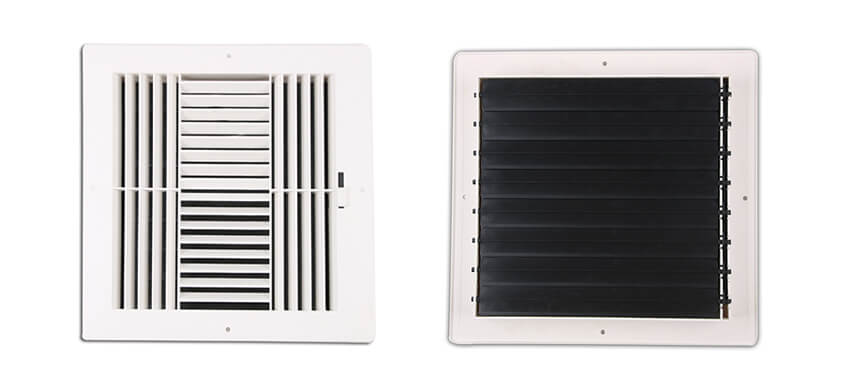
4. How do I choose the right size and type of plastic air diffuser for my building?
Choosing the right plastic air diffuser involves a balance of technical specifications, room characteristics, and aesthetic considerations. By carefully evaluating these factors, you can ensure effective air distribution, energy efficiency, and overall comfort in your building.
1. Assessing the Room’s Airflow Requirements
- Understand Air Volume: Calculate the volume of air that needs to be distributed in the space. This is determined by the room size and the HVAC system’s capacity.
- Consider Air Change Rate: Factor in the air change rate required for the space, which varies depending on its use (e.g., office, warehouse, residential).
2. Determining the Right Size
- Match with Duct Size: The diffuser size should correspond to the size of the ductwork to ensure efficient airflow.
- Avoid Oversizing: Oversized diffusers can lead to inefficient air distribution and temperature inconsistencies.
3. Choosing the Diffuser Type Based on Room Use
- Ceiling Diffusers for General Use: In most office and residential settings, standard ceiling diffusers provide even air distribution.
- Linear Slot Diffusers for Aesthetics: For modern interiors or spaces requiring a discreet appearance, linear slot diffusers are ideal.
- Swirl Diffusers for Large Spaces: In large, open areas like auditoriums or showrooms, swirl diffusers can enhance air mixing and comfort.
4. Considering Aesthetic Preferences
- Design and Color: Select a style and color that complements the interior design of your building. Plastic diffusers offer versatility in design and finishes.
- Architectural Integration: Consider how the diffuser will blend with the architectural elements of the room.
5. Evaluating the Installation Location
- Ceiling Height: The effectiveness of diffusers varies with ceiling height. In high-ceilinged spaces, diffusers that direct air vertically may be more effective.
- Obstructions and Layout: Account for any potential obstructions (like partitions) that might affect air distribution.
6. Consulting with HVAC Professionals
- Expert Advice: For the best results, consult with HVAC professionals. They can provide valuable insights based on the specific characteristics of your building and its ventilation needs.
5. Can plastic air diffusers be used in both residential and commercial settings?
Plastic air diffusers are a flexible and practical choice for both residential and commercial settings. Their versatility, combined with functional and aesthetic adaptability, makes them suitable for a wide range of applications, contributing to the efficiency and comfort of HVAC systems in diverse environments.
1. Adaptability in Residential Settings
- Aesthetic Appeal: Plastic diffusers offer a range of designs and colors, making them an attractive option for various home styles.
- Size Variability: Available in sizes that fit standard residential ductwork, they are ideal for evenly distributing air in living rooms, bedrooms, and kitchens.
- Noise Reduction: Their composition helps dampen noise, which is a significant consideration in quieter residential areas.
2. Functionality in Commercial Environments
- Durability for High Usage: Commercial-grade plastic diffusers are designed to withstand more frequent use, making them durable for settings like offices, malls, or hospitals.
- Airflow Efficiency: They effectively manage air distribution in larger spaces, ensuring comfort in commercial settings.
- Cost-Effectiveness: Plastic diffusers can be a more economical choice for larger commercial installations without compromising quality.
3. Health and Safety Considerations
- Hygienic and Easy to Clean: Plastic diffusers resist dust accumulation and are easy to clean, an essential factor in both homes and commercial buildings where air quality is a priority.
- Fire Safety: Look for fire-resistant plastic materials when choosing diffusers, especially important in commercial settings.
4. Environmental Adaptability
- Resistance to Corrosion: In areas with high humidity or specific environmental conditions, plastic diffusers offer excellent corrosion resistance compared to metal options.
- UV Stability: Some plastic diffusers are treated for UV stability, making them suitable for areas exposed to sunlight.
5. Energy Efficiency Aspects
- Insulative Properties: Plastic’s lower thermal conductivity can contribute to better energy efficiency in HVAC systems, reducing heat loss and improving overall system performance.
6. Tailoring to Specific Needs
- Customization: Manufacturers often provide customizable options for both residential and commercial projects, catering to unique airflow and aesthetic requirements.
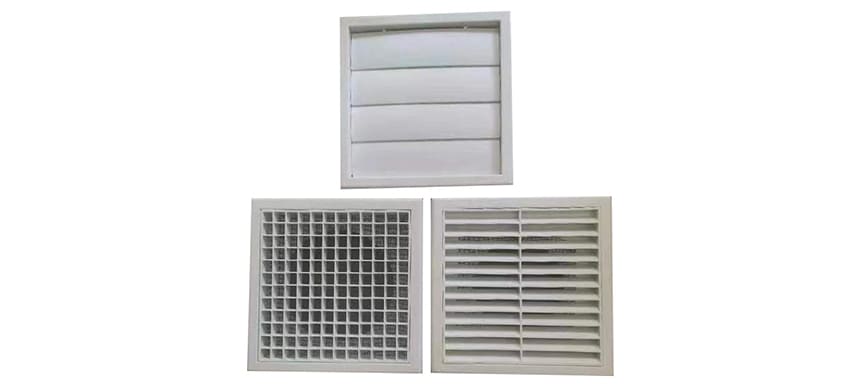
6. What are the key factors to consider when selecting plastic louvers for outdoor use?
Selecting plastic louvers for outdoor use requires a balance of functional requirements, durability, aesthetic considerations, and compliance with safety standards. By carefully evaluating these factors, you can ensure that the louvers not only meet your ventilation needs but also enhance the building’s overall functionality and appearance.
1. Material Durability and Quality
- UV Resistance: Ensure the plastic is UV stabilized to withstand prolonged exposure to sunlight without degrading.
- Weather Resistance: The material should be capable of enduring various weather conditions, including rain, wind, and temperature extremes.
- Quality Certification: Look for louvers made of high-quality plastics with certifications or ratings that attest to their durability.
2. Size and Airflow Requirements
- Appropriate Sizing: Match the louver size with the ventilation requirements of the space. Incorrect sizing can lead to inadequate airflow or unnecessary strain on HVAC systems.
- Airflow Efficiency: Consider the design’s effectiveness in providing the necessary air exchange while preventing the ingress of water and debris.
3. Corrosion Resistance
- Suitability for Humid Environments: In areas with high humidity or coastal regions, the louvers should be highly resistant to corrosion and salt damage.
4. Aesthetic and Architectural Compatibility
- Design and Color Options: Choose louvers that complement the building’s exterior design. Aesthetic appeal is important, especially in visible installations.
- Integration with the Building Façade: Ensure that the louvers can be integrated seamlessly with the building’s façade, considering factors like color, shape, and style.
5. Installation and Maintenance Ease
- Ease of Installation: Consider the installation process. Louvers that are easy to install can reduce labor costs and installation time.
- Low Maintenance: Opt for louvers that require minimal maintenance, considering their accessibility for cleaning and repairs.
6. Energy Efficiency Contribution
- Thermal Performance: Evaluate how the louvers will contribute to the building’s overall energy efficiency, particularly in terms of heat gain or loss.
7. Safety and Compliance
- Building Codes and Regulations: Verify that the louvers comply with local building codes and regulations, especially in terms of fire safety and environmental impact.
- Certifications: Look for products that have been tested and certified for safety and performance standards.
7. How do plastic grilles impact the efficiency of an HVAC system?
In HVAC (Heating, Ventilation, and Air Conditioning) systems, the choice of components can significantly influence overall efficiency. Plastic grilles, often used in various HVAC setups, bring unique properties that can affect system performance.
Understanding the Role of Plastic Grilles in HVAC Efficiency
1. Lightweight Design and Installation Ease:
- Ease of Handling: Plastic grilles are lightweight, making them easy to handle and install. This can lead to quicker and more efficient installation processes, minimizing labor costs.
- Flexibility in Design: Their lightweight nature also allows for more design flexibility, which can contribute to better airflow management within the system.
2. Durability and Maintenance:
- Resistance to Corrosion: Unlike metal grilles, plastic grilles are resistant to corrosion. This property is particularly beneficial in environments with high humidity or corrosive elements, contributing to the longevity of the grille and consistent airflow efficiency.
- Low Maintenance Requirements: Plastic grilles require less maintenance compared to their metal counterparts. Their durability and resistance to rust mean they maintain their performance over time with minimal upkeep.
3. Airflow Dynamics and Performance:
- Smooth Surface for Airflow: Plastic grilles often have a smooth surface, which can facilitate more efficient airflow with less resistance compared to rougher materials.
- Design Versatility for Optimal Air Distribution: Advanced manufacturing techniques allow for plastic grilles to be designed in ways that optimize air distribution, potentially enhancing the overall efficiency of the HVAC system.
4. Insulation Properties:
- Thermal Insulation: Plastic materials generally have good insulating properties. This can reduce the amount of heat loss or gain through the grille, contributing to the energy efficiency of the HVAC system.
- Impact on Temperature Regulation: Better insulation means the HVAC system may require less energy to maintain desired temperatures, leading to energy savings.
5. Cost-Effectiveness:
- Affordability: Plastic grilles are typically more cost-effective than metal grilles. This cost efficiency can be an advantage in large-scale HVAC installations where the number of grilles required is high.
- Energy Cost Reduction: In addition to the initial purchase savings, the energy efficiency aspects of plastic grilles can contribute to lower operational costs over time.
Plastic grilles can positively impact the efficiency of HVAC systems through their lightweight design, durability, efficient airflow dynamics, insulating properties, and cost-effectiveness. Their resistance to corrosion and low maintenance needs further add to their appeal. When considering plastic grilles for HVAC systems, it’s important to balance these efficiency benefits with other factors like specific environmental conditions and overall system requirements to ensure optimal performance and longevity of the system.
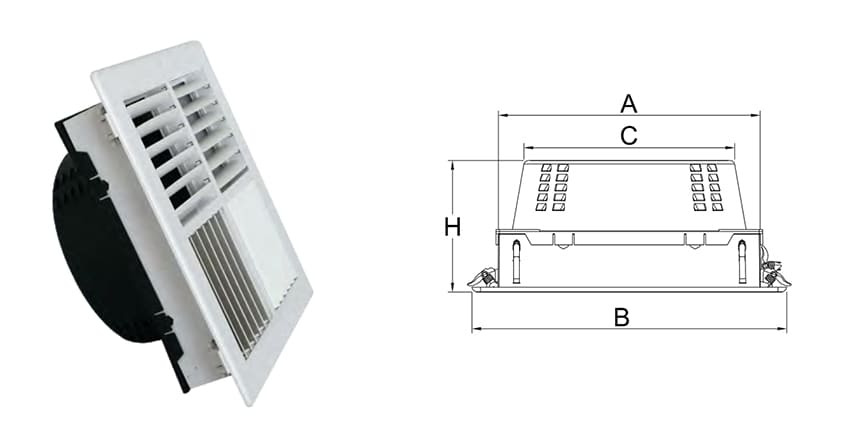
8. Are there customizable options available for plastic air diffusers and grilles?
Customizable options for plastic air diffusers and grilles have expanded significantly, offering solutions that are tailored to specific sizes, colors, designs, and functional needs.
Exploring Customizable Features of Plastic Air Diffusers and Grilles
1. Variety in Sizes and Shapes:
- Tailored Dimensions: Plastic air diffusers and grilles can be manufactured in a range of sizes and shapes, accommodating unique spatial requirements and airflow needs.
- Shape Flexibility: From standard square and circular designs to more intricate shapes, the versatility of plastic allows for greater customization to fit specific design schemes.
2. Color and Finish Options:
- Aesthetic Integration: A significant advantage of plastic diffusers and grilles is the ability to produce them in various colors. This feature enables them to blend seamlessly with the interior décor or to stand out as a design element.
- Finish Varieties: Beyond basic colors, finishes can range from matte, and glossy, to textured, providing additional aesthetic appeal.
3. Adjustable Airflow Mechanisms:
- Custom Airflow Control: Some plastic diffusers and grilles come with adjustable features, allowing control over the direction and volume of airflow. These customizable airflow options are particularly beneficial in optimizing indoor air circulation and comfort.
4. Custom-Made Patterns and Designs:
- Personalized Patterns: With advanced manufacturing techniques, plastic grilles, and diffusers can be crafted with custom patterns and designs, offering a unique touch to the installation space.
- Innovative Styles: From geometric patterns to thematic designs, customization can extend to align with specific architectural themes or branding requirements.
5. Material Enhancements
- Enhanced Durability: For demanding environments, plastic diffusers and grilles can be reinforced with additional materials for increased strength and longevity.
- Specialized Treatments: Treatments for UV resistance, antimicrobial properties, or fire retardancy can be applied based on the specific application requirements.
Consulting with Experts: Engaging with HVAC professionals or designers.
9. What maintenance is required for plastic HVAC vents and grilles?
Regular and proper maintenance of plastic HVAC vents and grilles is crucial to ensure they function efficiently and maintain their appearance. Simple steps like routine cleaning, using appropriate cleaning agents, inspecting for damage, ensuring a secure fit, and protecting them from direct heat can significantly extend their lifespan, and also contribute to a healthy and comfortable indoor environment.
Maintaining Plastic HVAC Vents and Grilles for Optimal Performance
1. Regular Cleaning:
- Dust and Debris Removal: Plastic vents and grilles can accumulate dust and debris over time. Regular cleaning, which involves gently wiping the surfaces with a soft cloth or using a vacuum with a brush attachment, is essential to prevent blockages and maintain air quality.
- Frequency of Cleaning: The cleaning frequency can depend on the environment; in dustier areas, more frequent cleaning may be necessary.
2. Gentle Cleaning Products:
- Avoid Harsh Chemicals: When deeper cleaning is needed, use mild detergents mixed with water. Harsh chemicals or abrasive cleaners can damage the plastic material, leading to discoloration or brittleness.
- Soft Brushes or Sponges: Use soft brushes or sponges to avoid scratching the surface of the vents and grilles.
3. Checking for Damage:
- Visual Inspections: Periodically inspect the plastic vents and grilles for any signs of damage, such as cracks, warping, or discoloration. These issues can affect their functionality and aesthetic appeal.
- Prompt Repairs or Replacements: Address any damage promptly, either by repairing minor issues or replacing the vent or grille if the damage is significant.
4. Ensuring Proper Fit and Alignment:
- Secure Installation: Over time, plastic vents and grilles may become loose. Check their fit and alignment, ensuring they are securely attached to the duct openings.
- Seal Integrity: Make sure the seals around the vents and grilles are intact to prevent air leakage, which can impact the efficiency of the HVAC system.
5. Avoiding Heat Exposure:
- Protect from Direct Heat: Excessive heat can warp or damage plastic. Ensure that vents and grilles are not exposed to direct heat sources, such as heaters or intense sunlight.
6. Seasonal Checks:
- Adapting to Seasonal Changes: In areas with significant seasonal changes, check the vents and grilles at the start of each season to address any potential issues caused by temperature fluctuations or humidity levels.

10. How do I install plastic air diffusers and grilles in a new or existing HVAC system?
Installing plastic air diffusers and grilles in an HVAC system is a task that can be accomplished with some basic DIY skills. Whether it’s a new installation or a replacement, the key is accurate measurement, careful alignment, and ensuring a secure and airtight fit.
1. Preparation
- Gather Tools and Materials: Ensure you have all necessary tools, such as a screwdriver, drill, tape measure, and air diffusers or grilles.
- Turn Off HVAC System: For safety, make sure the HVAC system is turned off before beginning installation.
2. Measuring and Marking
- Measure the Opening: Measure the opening where the diffuser or grille will be installed. It’s essential that the size of the opening matches the dimensions of the product for a snug fit.
- Mark the Installation Points: If drilling is needed, mark the points on the wall or ceiling where the screws will go.
3. Cutting or Adjusting Openings (If Necessary)
- Adjusting for Size: If the opening is too small, use appropriate tools to enlarge it. Ensure the new dimensions precisely match the diffuser or grille.
- Be Precise: Avoid making the opening too large, as this can lead to installation issues and poor aesthetic results.
4. Securing the Diffuser or Grille
- Positioning: Carefully place the diffuser or grille into the opening.
- Screwing in Place: Secure it with screws. Be careful not to overtighten, as this might crack the plastic.
5. Adjusting for Airflow (If Applicable)
- Adjustable Models: If your diffuser or grille has adjustable features, set them according to the desired airflow direction and intensity.
6. Testing and Final Adjustments
- Test for Airflow: Once installed, turn the HVAC system back on and check if the air is flowing correctly through the new diffuser or grille.
- Make Necessary Adjustments: If the airflow is not as expected, make further adjustments to the positioning or settings.
7. Finishing Touches
- Aesthetic Checks: Ensure the diffuser or grille is aligned properly and looks aesthetically pleasing.
- Sealing Gaps: If there are any gaps between the diffuser or grille and the surface, use an appropriate sealant to fill them, ensuring a neat finish.
8. Regular Maintenance
- Cleaning and Inspection: Regularly clean and inspect the diffusers and grilles to maintain optimal airflow and system efficiency.

11. What is the lifespan of plastic air diffusers and grilles?
On average, plastic air diffusers and grilles are designed to serve effectively for a period ranging from 5 to 10 years. This lifespan can be influenced by various factors, which we will explore in detail.
Influential Factors
- Material Quality: The longevity of plastic diffusers and grilles is directly related to the quality of plastic used. Higher-grade plastics usually offer enhanced durability.
- Environmental Exposure: The environment in which these components are installed plays a significant role. Factors like extreme temperature fluctuations, moisture levels, and exposure to chemicals can impact their lifespan.
- Maintenance Routine: Consistent and proper maintenance can greatly extend the life of these HVAC components.
12. How do plastic air diffusers contribute to indoor air quality?
Air diffusers are responsible for distributing air evenly throughout a space. They work by directing airflow in patterns that ensure a consistent and comfortable environment. The use of plastic in these diffusers has become prevalent due to its flexibility and efficiency in air distribution.
Impact on Indoor Air Quality
- Even Distribution of Air: Plastic air diffusers help in evenly spreading conditioned air throughout a room. This uniform distribution prevents the formation of air pockets, which can lead to stagnant air and uneven temperatures.
- Reduced Contaminants: By facilitating proper air circulation, these diffusers help reduce the concentration of airborne contaminants like dust, pollen, and other allergens.
- Humidity Control: Effective air distribution also assists in maintaining balanced humidity levels. This is crucial in preventing the growth of mold and mildew, which can adversely affect air quality.
Key Takeaways for Optimal Air Quality
- Regular Maintenance: Keep air diffusers clean to maintain their efficiency.
- Appropriate Sizing and Installation: Ensure that diffusers are correctly sized and installed for your specific space.
- Professional Assessment: Consider consulting with HVAC experts to optimize your system for the best indoor air quality possible.
13. Can plastic louvers and grilles be painted or modified to match interior decor?
Plastic louvers and grilles can indeed be painted or modified to match the interior decor, providing a harmonious and integrated look. This flexibility allows for a creative approach to HVAC components, turning them from purely functional to decorative elements.
Preparing for Painting
- Surface Preparation: Before painting, it’s crucial to clean the plastic surface thoroughly to remove dust, grime, and oils. Light sanding may also be necessary to create a surface that the paint can adhere to.
- Choosing the Right Paint: Use a paint specifically designed for plastic surfaces. These paints adhere better and are less likely to chip or peel over time.
- Application Technique: Applying multiple thin coats is preferable to a single thick coat to avoid drips and ensure an even finish.
Modification Considerations
Modifying the shape or size of plastic louvers and grilles is more complex and may require professional assistance. It’s important to ensure that any modifications do not impede the functionality of the HVAC system.
Color and Design Choices
When choosing colors or designs, consider the overall color scheme and style of the room. Neutral tones can blend seamlessly, while bold colors or patterns can make a statement.
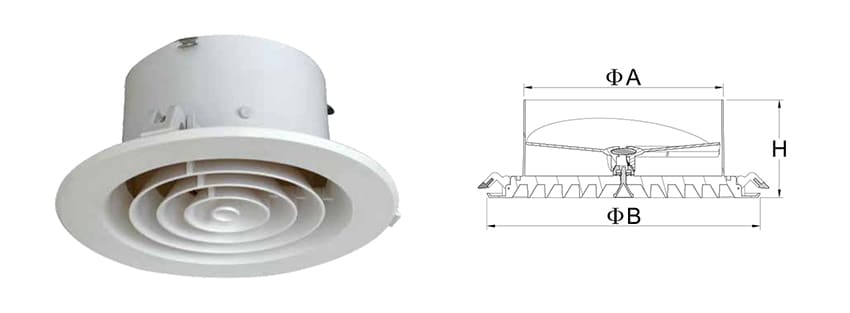
14. What are the latest trends and innovations in plastic air diffuser technology?
The landscape of plastic air diffuser technology is rapidly changing, with energy efficiency, aesthetic integration, sustainability, and technological advancements leading the way. These innovations not only enhance the functionality of HVAC systems but also contribute to a more sustainable and aesthetically pleasing environment.
1: Enhanced Energy Efficiency
One of the primary trends in air diffuser technology is the focus on energy efficiency. New designs and materials are being developed to optimize airflow, reduce energy consumption, and lower operational costs.
- Smart Diffusers: Incorporating smart technology, these diffusers can adjust airflow based on room occupancy or temperature, leading to significant energy savings.
- Improved Aerodynamics: Advances in design are enabling more efficient air distribution, reducing the strain on HVAC systems.
2: Aesthetic Integration
Modern plastic air diffusers are being designed with a greater emphasis on aesthetics, allowing them to seamlessly integrate into various interior designs.
- Customizable Designs: Manufacturers are offering more options in terms of colors, shapes, and sizes to match different decor styles.
- Minimalist Appearance: Trends are moving towards sleeker, more unobtrusive designs that blend into the ceiling or walls.
3: Eco-Friendly Materials
With a growing emphasis on sustainability, the use of eco-friendly materials in air diffusers is on the rise.
- Recycled Plastics: Utilizing recycled plastics reduces waste and environmental impact without compromising on performance.
- Biodegradable Options: Research is underway to develop biodegradable plastics for air diffusers, offering an environmentally responsible alternative.
4: Technological Integration
Technology integration is another key trend, with features that enhance user experience and system efficiency.
- IoT Compatibility: Some diffusers are now compatible with Internet of Things (IoT) platforms, enabling remote control and monitoring.
- Advanced Filtration Systems: Innovations in filtration are being incorporated to improve indoor air quality, capturing finer particles and pollutants.
15. How do plastic grilles and diffusers perform in extreme weather conditions?
Plastic grilles and diffusers offer reliable performance in extreme weather conditions. Their resistance to heat, cold, moisture, UV radiation, and impact makes them a durable choice for HVAC systems in various environmental settings, ensuring long-lasting functionality and efficiency.
1: Performance in High Temperatures
In regions with high temperatures, plastic grilles, and diffusers are subjected to intense heat and sunlight.
- Heat Resistance: Modern plastics are often designed to withstand high temperatures without warping or losing shape.
- UV Stability: Exposure to UV rays can be a concern, but many plastic grilles and diffusers are treated with UV stabilizers to prevent degradation.
2: Endurance in Cold Climates
In colder climates, these components face the challenge of freezing temperatures.
- Brittleness Threshold: While some plastics can become brittle in cold conditions, advancements in materials have led to more cold-resistant varieties.
- Thermal Expansion and Contraction: Plastics that can tolerate the thermal expansion and contraction that occurs with temperature fluctuations perform better in cold weather.
3: Resistance to Moisture and Humidity
High levels of moisture and humidity can also impact plastic grilles and diffusers.
- Moisture Resistance: Quality plastic materials are generally resistant to moisture, preventing swelling or mold growth.
- Humidity Effects: In humid conditions, plastics designed to resist humidity-induced warping maintain their shape and functionality.
4: Durability Against Wind and Storms
Extreme weather conditions like strong winds and storms test the durability of these components.
- Wind Resistance: The structural integrity of plastic grilles and diffusers is key to their ability to withstand high winds.
- Impact Resistance: Enhanced plastics are often used for their ability to resist damage from flying debris during storms.
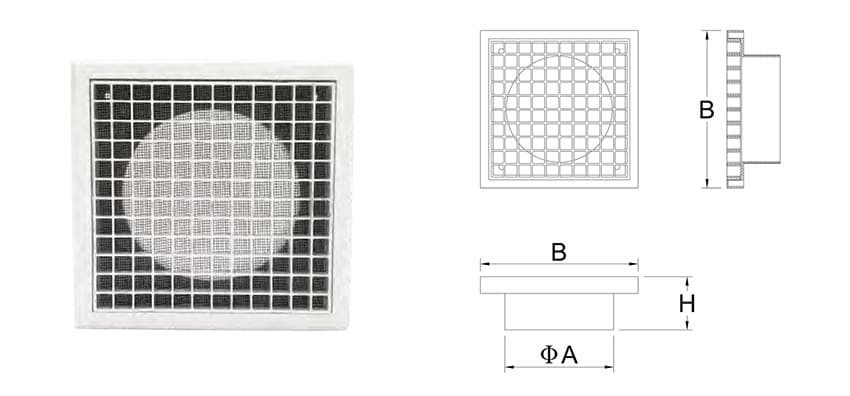
16. Are there energy-efficient models of plastic air diffusers and grilles?
Yes, contact us, or please check below to know some.
There is a growing trend in the HVAC industry towards energy conservation, leading to an increased availability of energy-efficient models of plastic air diffusers and grilles. Many manufacturers are now prioritizing the development of energy-efficient models to meet both consumer demand and regulatory standards.
These models are often designed with improved airflow dynamics, ensuring that air is distributed more efficiently throughout the space, which can reduce the load on HVAC systems. Some models incorporate advanced technologies that enhance ventilation effectiveness without increasing energy consumption.
Features of Energy-Efficient Models:
- Aerodynamic Design: Energy-efficient diffusers and grilles often feature aerodynamic designs that minimize resistance to airflow, thereby reducing the energy needed for air distribution.
- Adjustable Controls: Some models come with adjustable settings that allow for better control of airflow, contributing to energy savings by avoiding over-ventilation.
Material Advantages:
- Lightweight and Durable: The use of high-quality, lightweight plastics not only ensures durability but also aids in the efficient performance of these components.
- Thermal Properties: Plastic materials with good insulating properties can help prevent unnecessary heat loss or gain through the diffuser or grille.
Compatibility with Smart HVAC Systems:
- Integration with Automated Systems: Many energy-efficient plastic diffusers and grilles are designed to be compatible with smart and automated HVAC systems, enhancing overall system efficiency.
- Responsive Adjustments: In smart HVAC setups, these components can adjust according to real-time environmental data, optimizing energy usage.
17. How do I properly measure and fit plastic air diffusers in ventilation ducts?
Properly measuring and fitting plastic air diffusers in ventilation ducts is a straightforward process that requires precision and attention to detail. Before beginning, gather all necessary tools and materials. You’ll need a tape measure, a screwdriver, possibly a drill, and your plastic air diffuser. Ensure the power to your HVAC system is turned off for safety.
1. Understanding Duct Dimensions
- Measure the Duct Opening: Start by accurately measuring the dimensions of the duct opening where the diffuser will be installed. It’s crucial to measure both the length and width to the nearest inch.
- Note the Shape: Pay attention to the shape of the duct opening – whether it’s round, square, or rectangular – as this will determine the shape of the diffuser needed.
2. Selecting the Right Size Diffuser
- Match with Duct Size: Choose a diffuser that matches the size of the duct opening. If the diffuser is too small, it won’t fit securely; if it’s too large, it won’t fit at all.
- Consider Airflow Requirements: Make sure the diffuser size is also appropriate for the room’s airflow needs. Larger rooms may require larger diffusers for effective air distribution.
3. Preparing for Installation
- Gather Necessary Tools: You’ll need tools such as a drill, screwdriver, and possibly a saw if adjustments to the duct opening are needed.
- Turn Off the HVAC System: For safety, ensure the HVAC system is turned off before beginning the installation process.
4. Fitting the Diffuser
- Test Fit: Before securing the diffuser, do a test fit to ensure it sits correctly in the duct opening.
- Secure in Place: If the fit is correct, secure the diffuser in place using screws. Some diffusers may simply clip or slide into place without the need for tools.
5. Ensuring Proper Airflow
- Adjustable Features: If your diffuser has adjustable features (like movable louvers), set them according to your desired airflow direction.
- Check for Obstructions: Ensure that there are no obstructions blocking the diffuser that could impede airflow.
6. Aesthetic Considerations
- Visual Alignment: Make sure the diffuser is aligned properly for a neat appearance. This is particularly important in areas where it is prominently visible.
- Finishing Touches: If necessary, apply any finishing touches, such as sealant or paint, to ensure the diffuser blends seamlessly with the surrounding area.
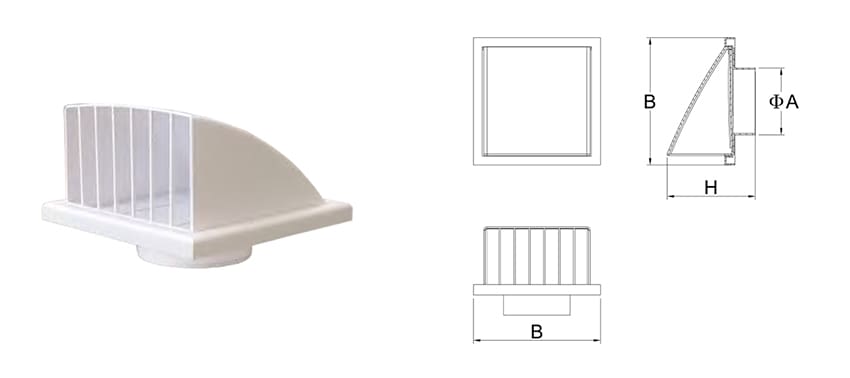
18. What is the cost comparison between plastic and other materials for air diffusers?
Air diffusers are made from various materials, each with its own cost implications. The most common materials include plastic, aluminum, steel, and wood.
Plastic Air Diffusers: The Economical Choice Plastic, known for its versatility and cost-effectiveness, stands out as a popular choice for air diffusers. Here’s why:
- Lower Manufacturing Costs: Plastic is generally less expensive to produce than metals or wood. This cost advantage is passed on to consumers, making plastic diffusers a budget-friendly option.
- Ease of Installation: Lighter in weight, plastic diffusers are simpler to handle and install, potentially reducing labor costs.
- Minimal Maintenance: Resistant to corrosion and rust, plastic requires less upkeep, saving on long-term maintenance expenses.
Comparing with Alternatives While plastic is a cost-effective option, other materials like aluminum, steel, and wood have their unique advantages:
- Aluminum and Steel: These materials are known for their durability and longevity. While initially more expensive, they may offer better long-term value for high-traffic areas or commercial settings.
- Wooden Diffusers: Offering aesthetic appeal, wooden diffusers can be pricier but add a premium look to interiors. They require more maintenance but are prized for their natural beauty.
The Balancing Act: Cost vs. Requirements The choice between plastic and other materials isn’t just about cost. It involves considering factors like:
- Aesthetic Needs: For design-centric spaces, wood or metal might be preferred despite the higher cost.
- Environmental Conditions: In humid or corrosive environments, the durability of metal might offset its higher initial cost.
- Performance Requirements: For specialized airflow needs, the material choice might be dictated by functional requirements rather than cost alone.
19. How do plastic air diffusers and grilles support noise reduction in HVAC systems?
Plastic air diffusers and grilles are instrumental in reducing noise levels in HVAC systems. Their sound-absorbing materials, design for smooth airflow, and vibration mitigation capabilities make them an ideal choice for environments where noise reduction is a priority, without compromising on air distribution efficiency.
1. Material Properties for Sound Dampening
- Inherent Sound Absorption: Unlike metal, plastic has natural sound-absorbing qualities. Its composition helps to dampen and reduce the transmission of noise generated by air movement.
- Highlight: This property is particularly beneficial in settings like hospitals, offices, or residential areas where minimal noise is desired.
2. Smooth Airflow Design
- Reduced Air Turbulence: Plastic diffusers and grilles are often designed with smooth surfaces and aerodynamic shapes. This design minimizes air turbulence, which is a common source of HVAC noise.
- Highlight: Smoother airflow results in quieter operation, enhancing comfort in occupied spaces.
3. Vibration Mitigation
- Less Vibration Transmission: Plastic’s flexibility and lower density compared to metal help in reducing the transmission of vibrations through the ductwork.
- Highlight: Vibration reduction is key to lowering the overall sound levels emitted by the HVAC system.
4. Integration with Sound Attenuation Systems
- Compatibility with Silencers: Plastic diffusers and grilles can be effectively integrated with sound attenuators or acoustic linings in ductwork, further enhancing their noise reduction capability.
- Highlight: This combination is effective in achieving the desired sound levels, especially in critical noise-sensitive environments.
5. Customizable Designs for Acoustic Optimization
- Design Flexibility: The malleability of plastic allows for the creation of custom designs that can be optimized for acoustic performance.
- Highlight: Tailored designs ensure that the diffusers and grilles complement the overall noise reduction strategy of the HVAC system.
6. Impact on Overall HVAC Efficiency
- Enhanced System Performance: By facilitating smoother and quieter airflow, plastic diffusers and grilles contribute to the overall efficiency of the HVAC system, as less energy is required to move air through the system.
- Highlight: Efficient systems tend to produce less operational noise, contributing to a quieter environment.
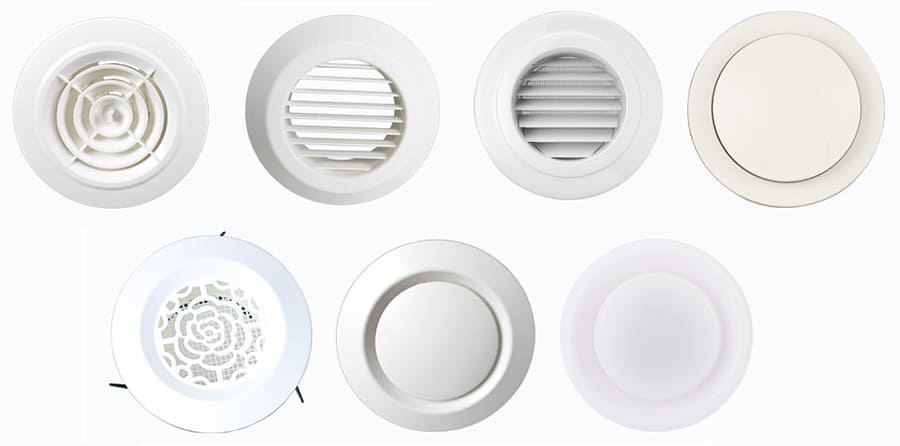
Need High-quality HVAC Grilles and Diffusers? Shoot us a message, and I’ll be happy to assist you in picking the right grilles or diffusers for your needs.

